Assessment of Regional Ecosystem Health—A Case Study of the Golden Triangle of Southern Fujian Province, China
Abstract
:1. Introduction
2. Materials and Methods
2.1. Study Area
2.2. Data Sources
2.3. Analysis of Landscape Pattern
2.3.1. Shannon’s Diversity Index
2.3.2. Shannon’s Evenness Index (SHEI)
2.3.3. Landscape Fragmentation Index (FN)
2.4. Evaluation Indexes Used in the PSR Model and Determination of Index Weight
2.4.1. PSR Model
2.4.2. Evaluation of Indexes
2.4.3. Determination of Index Weight
- , Element and element j are of the same importance to the upper level
- , Element is slightly more important than element j
- , Element is more important than element j
- , Element is much more important than element j
- , Element is of even greater importance than element j
- , n = 1, 2, 3, 4… The importance of elements i and j are between and
2.5. Evaluation Method
2.5.1. Standardization of Indexes
2.5.2. Comprehensive Evaluation of Ecosystem Health
3. Results
3.1. Landscape Pattern Analysis
3.1.1. Shannon’s Diversity Index (H)
3.1.2. Shannon’s Evenness Index (SHEI)
3.1.3. FN
3.2. Evaluation of Ecosystem Health
3.3. Analysis of Regional Ecosystem Health Elements in the Study Areas
3.3.1. Pressure
3.3.2. State
3.3.3. Response
4. Discussion
4.1. Identification of Main Controlling Factors
4.2. Spatial Correlation between Ecological Health and Urbanization
4.3. Sensitivity of the Indexes Used to Evaluate Ecological Health
4.4. Innovation and Prospect
4.4.1. Innovation Compared with Other Authors’ Previous Works
4.4.2. Future Work Prospect
5. Conclusions
- (1)
- There is a wide variation in the ecosystem health of different cities; this is primarily due to the extremely low ecosystem health status of Xiamen compared with Zhangzhou and Quanzhou. The poor ecosystem health of Xiamen is primarily due to its development as the political, economic, and cultural center of Fujian. In Xiamen, economic development, urban infrastructure, and environmental facilities are superior to those in in Zhangzhou and Quanzhou.
- (2)
- Ecosystem health is determined by the interactions between numerous ecological factors. In order to understand the influence of these factors on the ecological health of the area, we calculated the main factors affecting ecosystem health. Ecosystem health states were calculated using the mean values of the primary ecological factors influencing the ecosystem and by determining the main control factors in different ecosystems.
- (3)
- Ecological health exhibits a significant negative correlation with the urbanization rate, GDP, and development in Southern Fujian. This suggests that urbanization and industrialization contribute to a decline in the ecosystem health.
- (4)
- Because of the gaps in the available data, we were unable to perform a longitudinal study assessing changes in ecosystem health in the study region over time. We will attempt to address this issue in future research.
Acknowledgments
Author Contributions
Conflicts of Interest
References
- Li, B. Xiamen-Zhangzhou-Quanzhou cities urban integration enclave economy mode business restructuring and cooperation. Spec. Zone Econ. 2012, 11, 17–19. (In Chinese) [Google Scholar]
- Li, B.; Li, X.; Bouma, T.J.; Soissons, L.M.; Cozzoli, F.; Wang, Q.; Zhou, Z.; Chen, L. Analysis of macrobenthic assemblages and ecological health of Yellow River Delta, China, using AMBI & M-AMBI assessment method. Mar. Pollut. Bull. 2017, 119, 23–32. [Google Scholar] [CrossRef] [PubMed]
- Wang, N.; Han, Y.; Huang, Y.; Ye, G. Study on the Assessment of Ecosystem Health of Fuzhou Built-up Area. Res. Soil Water Conserv. 2014, 21, 200–204. [Google Scholar] [CrossRef]
- Cai, A.-P. Ecosystem health assessment and ana1ysis in the coastal zone of Fujian province. Straits Sci. 2011, 12, 30–34. [Google Scholar] [CrossRef]
- Sun, T.; Lin, W.; Chen, G.; Guo, P.; Zeng, Y. Wetland ecosystem health assessment through integrating remote sensing and inventory data with an assessment model for the Hangzhou Bay, China. Sci. Total Environ. 2016, 566–567, 627–640. [Google Scholar] [CrossRef]
- Guan, D.J.; Gao, W.J.; Watari, K.; Fukahori, H. Study on integrated evaluation of urban ecosystem health. J. South China Univ. Technol. (Nat. Sci. Ed.) 2007, 35, 175–178. [Google Scholar] [CrossRef]
- Cheng, X.; Chen, L.; Sun, R.; Kong, P. Land use changes and socio-economic development strongly deteriorate river ecosystem health in one of the largest basins in China. Sci. Total Environ. 2017, 616–617, 376–385. [Google Scholar] [CrossRef] [PubMed]
- Rapport, D.J.; Böhm, G.; Buckingham, D.; Cairns, J.; Costanza, R.; Karr, J.R.; De Kruijf, H.A.; Levins, R.; McMichael, A.J.; Nielsen, N.O.; et al. Ecosystem health: The concept, the ISEH, and the important tasks ahead. Ecosyst. Health 1999, 5, 82–90. [Google Scholar] [CrossRef]
- McMulltan, C. Indicators of Urban Ecosystems Health; International Development Research Centre (IDRC): Ottawa, ON, Canada, 1997. [Google Scholar]
- Hu, Ti.; Yang, Z.; He, M.; Zhao, Y. An urban ecosystem health assessment method and its application. Acta Sci. Circumst. 2005, 26, 269–274. [Google Scholar] [CrossRef]
- Tao, P.; Gao, W.; Sui, P. Discussion on indicator system of farmland ecosystem health assessment. J. China Agric. Univ. 2004, 9, 21–25. [Google Scholar] [CrossRef]
- Dehui, Z.; Fengqi, J.; Zhiping, F.; Xiaojun, D. Ecosystem health and sustainable development for human. Chin. J. Appl. Ecol. 1999, 10, 751–756. [Google Scholar] [CrossRef]
- Ren, H.; Wu, J.G.; Peng, S.L. Evaluation and monitoring of ecosystem health. Trop. Geogr. 2000, 20, 310–316. [Google Scholar] [CrossRef]
- Fu, B.; Liu, S.L.; Ma, K.M. The contents and methods of integrated ecosystem assessment. Acta Ecol. Sin. 2001, 21, 1885–1892. [Google Scholar] [CrossRef]
- Keming, M.A.; Hongmei, K. Ecosystem health assessment: Methods and directions. Acta Ecol. Sin. 2001, 21, 2106–2116. [Google Scholar] [CrossRef]
- Li, J.; Shu, Q.; Cheng, X.; Wang, Y.; Zhuo, Y.; Qin, F. Advances in Assessment of Ecosystem Health. Acta Phytoecol. Sin. 2001, 25, 641–647. [Google Scholar]
- Xiao, F.; Ouyang, H. Ecosystem health and its evolution indicator and method. J. Nat. Resour. 2002, 17, 203–209. [Google Scholar] [CrossRef]
- Kong, H.; Zhao, J.; Wu, G.; Ma, K. Ecosystem Health and Environmental Management. Chin. J. Environ. Sci. 2002, 23. [Google Scholar] [CrossRef]
- Tang, T.; Cai, Q.; Liu, J. River ecosystem health and its assessment. Chin. J. Appl. Ecol. 2002, 13, 1191–1194. [Google Scholar] [CrossRef]
- O’neill, R.V.; Riitters, K.H.; Wickham, J.D.; Jones, K.B. Landscape Pattern Metrics and Regional Assessment. Ecosyst. Health 2010, 5, 225–233. [Google Scholar] [CrossRef]
- Riitters, K.H.; O’neill, R.V.; Hunsaker, C.T.; Wickham, J.D.; Yankee, D.H.; Timmins, S.P.; Jones, K.B.; Jackson, B.L. A factor analysis of landscape pattern and structure metrics. Landsc. Ecol. 1995, 10, 23–39. [Google Scholar] [CrossRef]
- Chen, W.; Xiao, D.; Li, X. Classification, application, and creation of landscape indices. Chin. J. Appl. Ecol. 2002, 121–125. [Google Scholar] [CrossRef]
- Zhang, L.; Xia, J.; Ye, W. Overview on Choosing Landscape Indices in Landscape Pattern Analysis. Yunnan Geogr. Environ. Res. 2008, 20, 38–43. [Google Scholar] [CrossRef]
- Tong, C. Review on Environmental Indicator Research. Res. Environ. 2000, 13. [Google Scholar] [CrossRef]
- Yan, L.; Wang, J.K.; Huang, H. An assessment of ecosystem health in Dongxi River Basin based on PSR framework. Resour. Sci. 2008, 30, 107–113. [Google Scholar]
- Mai, S.Z.; Xu, S.J.; Pan, Y. Application of the PSR model to the evaluation of wetland ecosystem health. Trop. Geogr. 2005, 25, 317–321. [Google Scholar]
- Qiu, L. Study on River Basin Ecosystem Health Diagnosing and Early-Warning Based on Immune Mechanism. Ph.D. Thesis, Hehai University, Nanjing, China, 2006. [Google Scholar]
- Zhang, X.; Shi, P. The assessment of urban ecosystem health based on PSR model—A case study of Lanzhou city. J. Arid Land Resour. Environ. 2010, 24, 77–82. [Google Scholar]
- Liu, M.; Dong, G. Ecosystem health assessment and driving force analysis in Qinhuangdao area based on RS & GIS. Geogr. Res. 2006, 25, 930–938. [Google Scholar] [CrossRef]
- Xie, H.L.; Li, B.; Wang, C.S.; Yang, B.; Zhang, X.S. Agroecosystem health assessment in western China. Acta Ecol. Sin. 2005, 25, 3028–3036. [Google Scholar] [CrossRef]
- Shang, Z.H.; Lin, P.S.; Peng, X.L. Ecosystem system health evaluation on soil erosion area in south china—A case study of wuhua county. J. Geol. Hazards Environ. Preserv. 2009, 20, 116–120. [Google Scholar] [CrossRef]
- Zhao, Z.Y.; Xu, F.L.; Zhan, W.; Hao, J.Y.; Zhang, Y.; Zhao, S.S.; Hu, W.P.; Tao, S. A quantitative method for assessing lake ecosystem health. Acta Ecol. Sin. 2005, 25, 1466–1474. [Google Scholar] [CrossRef]
- Xu, W.J.; Cao, S.L. Health Assessment of Urban Lake Ecosystem Based on PSR-Entropy Weight Comprehensive Health Index Method. J. China Hydrol. 2010, 30, 64–68. [Google Scholar] [CrossRef]
- Guan, D.J.; Su, W.C. Study on evaluation method for urban ecosystem health and its application. Acta Sci. Circumst. 2006, 26, 1716–1722. [Google Scholar] [CrossRef]
- Wen, S.Y.; Zhao, D.Z.; Chen, Y.L.; Yang, F.; Ma, X.F. Research on Index Weighting of Risk Assessment of Harmful Algal Bloom Hazard Based on AHP. J. Catastrophol. 2007, 22, 9–14. [Google Scholar] [CrossRef]
- Zhang, Z. Research on the Analysis of Landscape Pattern and the Assessment of County Ecosystem Health. Master’s Thesis, Hebei Normal University, Shijiazhuang, China, 2010. [Google Scholar]
- Yu, Y.J.; Guo, H.C.; Liu, Y.; Jiang, Y.M.; Li, Y.Q.; Huang, K. Syndromic city illnesses diagnosis and urban ecosystem health assessment. Acta Ecol. Sin. 2008, 28, 1736–1747. [Google Scholar] [CrossRef]
- Guo, X.; Yang, J.; Mao, X. Primary studies on urban ecosystem health assessment. China Environ. Sci. 2002, 22, 525–529. [Google Scholar] [CrossRef]
- Su, M.R.; Yang, Z.F.; Wang, H.R.; Yang, X.H. A kind of method and its application for urban ecosystem health assessment. Acta Sci. Circumst. 2006, 26, 269–274. [Google Scholar] [CrossRef]
- Yang, Z.; He, M. Urban Ecological Sustainable Development Plan; Science Press: Beijing, China, 2004; Volume 25, p. 1019. [Google Scholar]
- Liu, K.; Ouyang, Z.; Wang, X.; Xu, W.; Hong, M. Eco-environmental sensitivity and its spatial distribution in Gansu Province. Acta Ecol. Sin. 2003, 23, 2711–2718. [Google Scholar] [CrossRef]
- Yan, L.; Xu, X.G.; Xie, Z.L.; Li, H.L. Integrated assessment on ecological sensitivity for Beijing. Acta Ecol. Sin. 2009, 29, 3117–3125. [Google Scholar] [CrossRef]
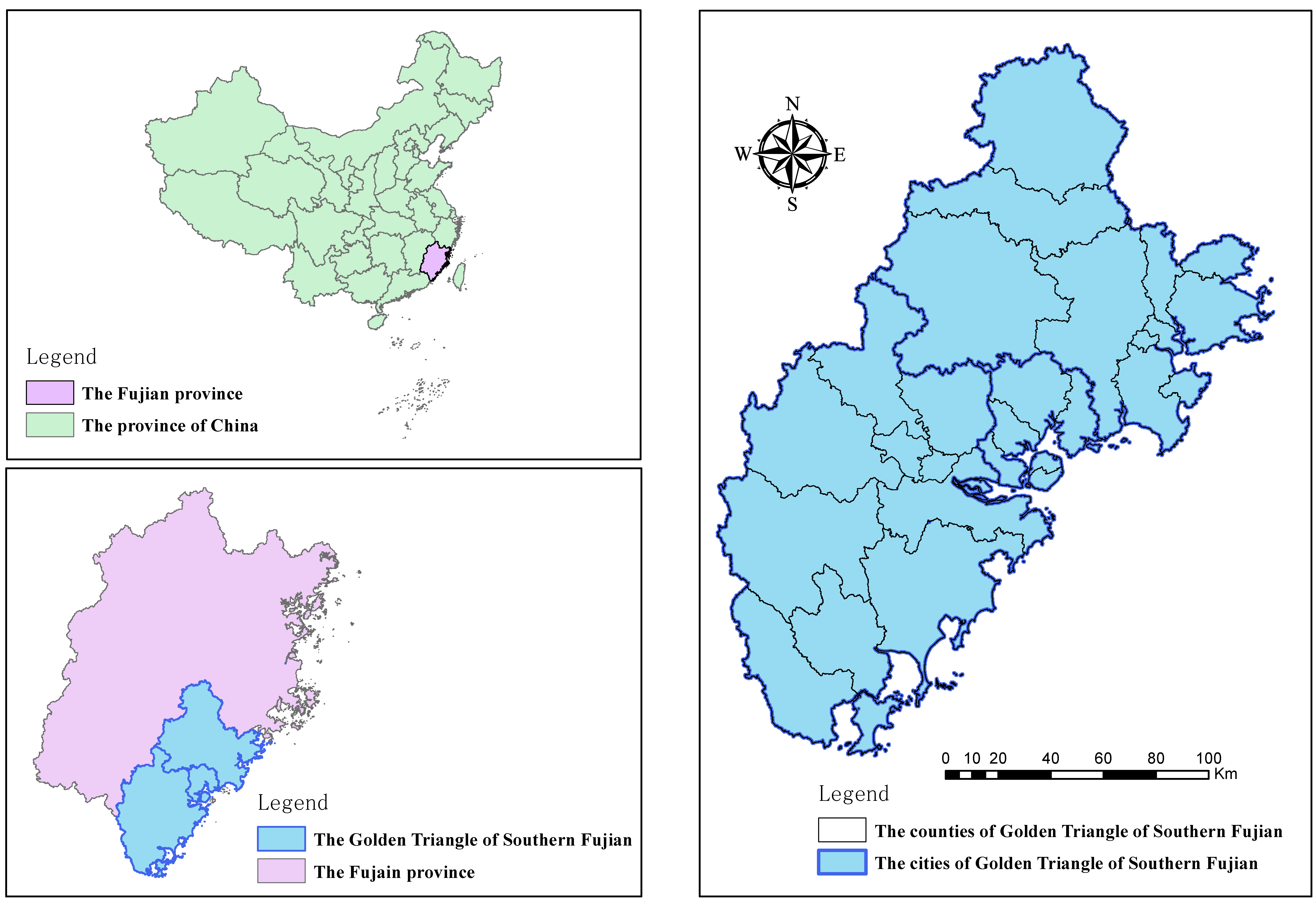
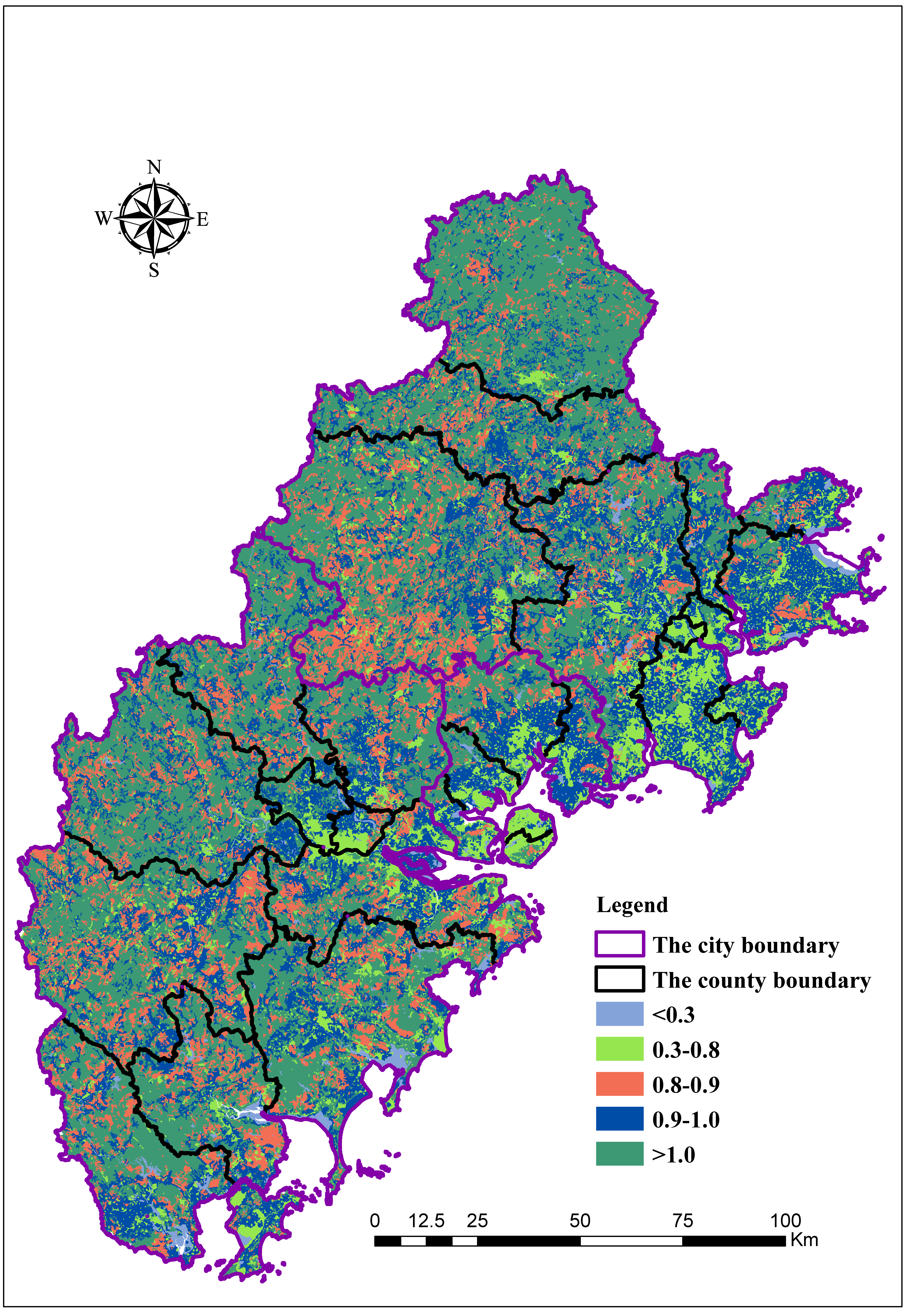
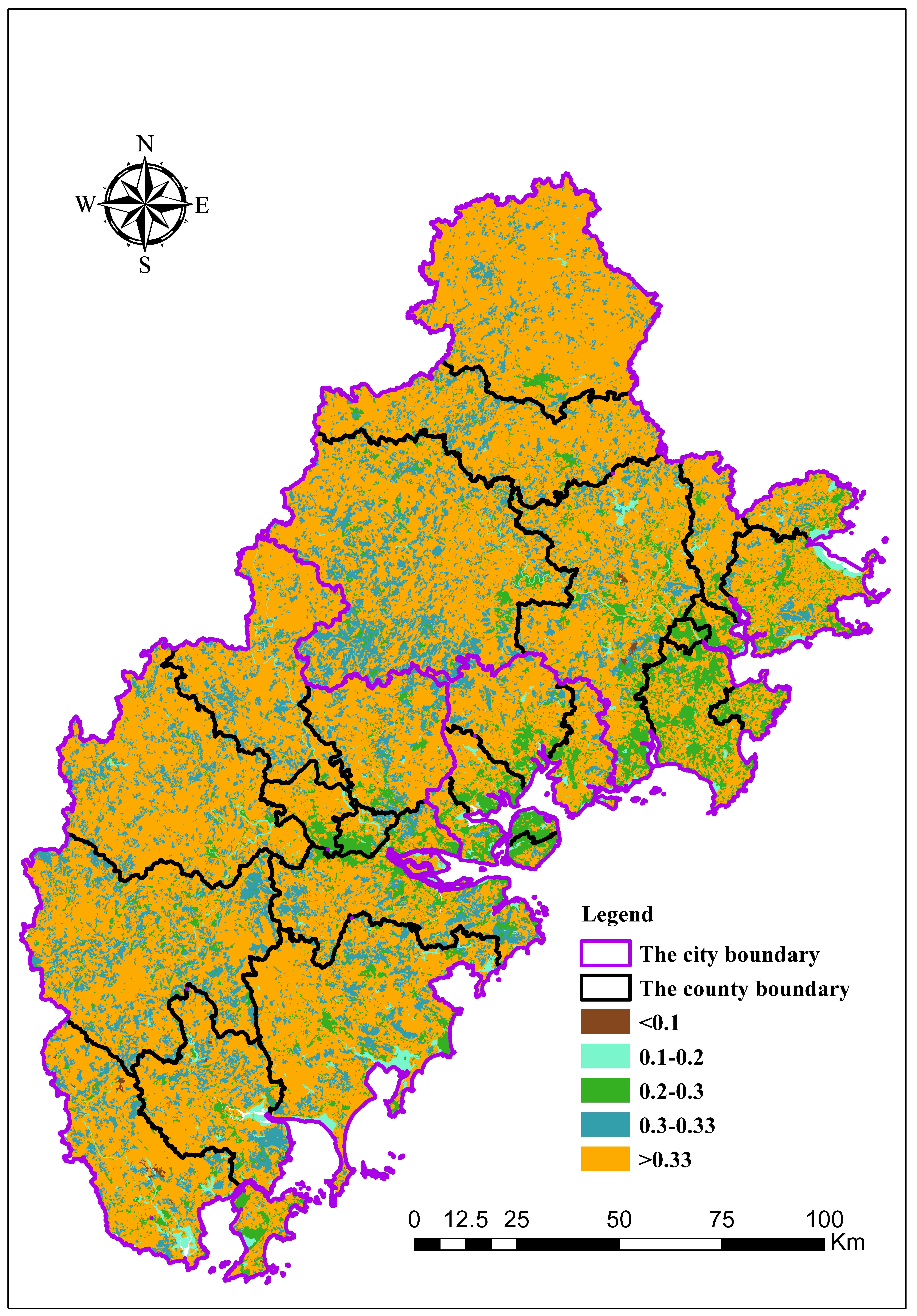



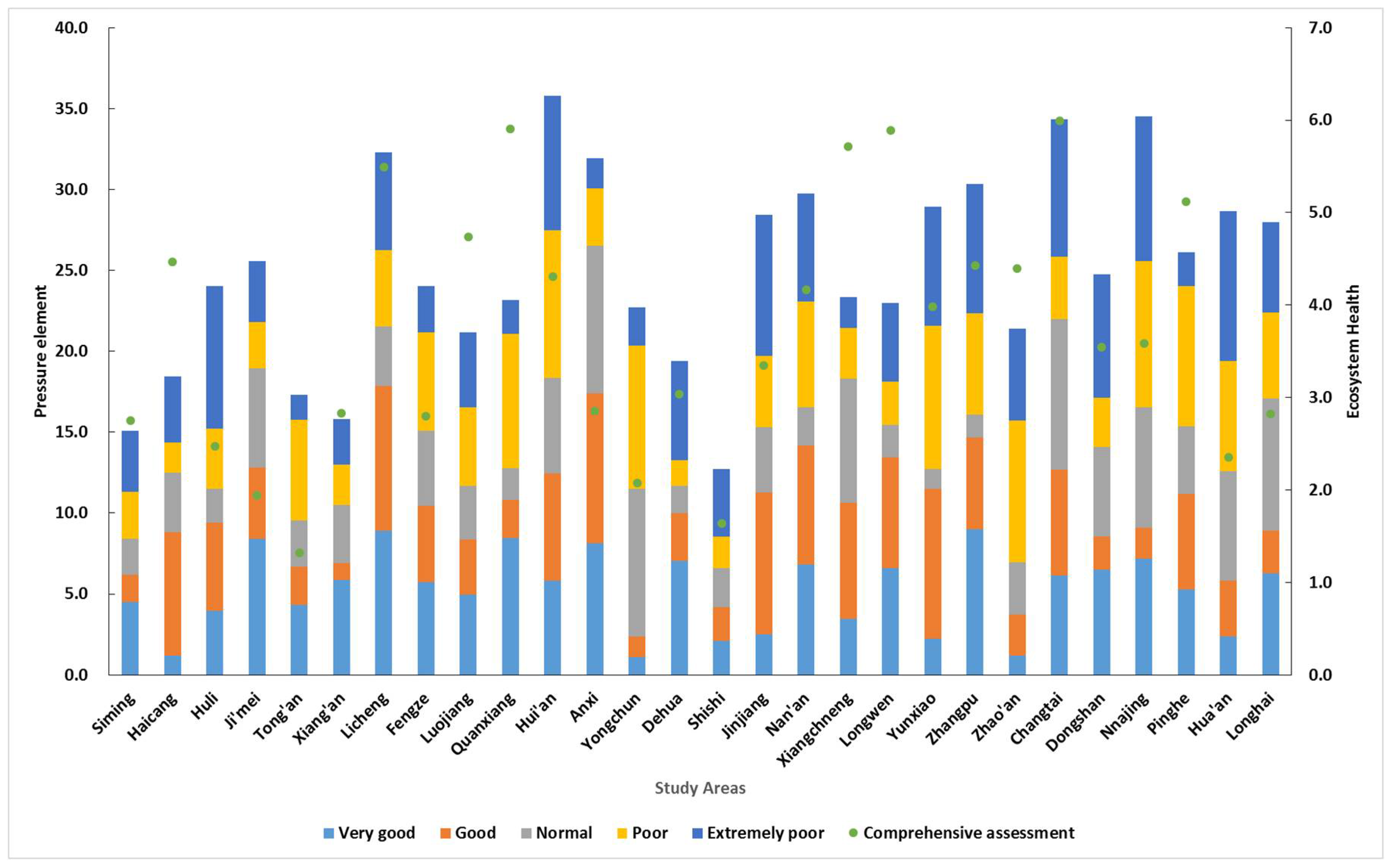


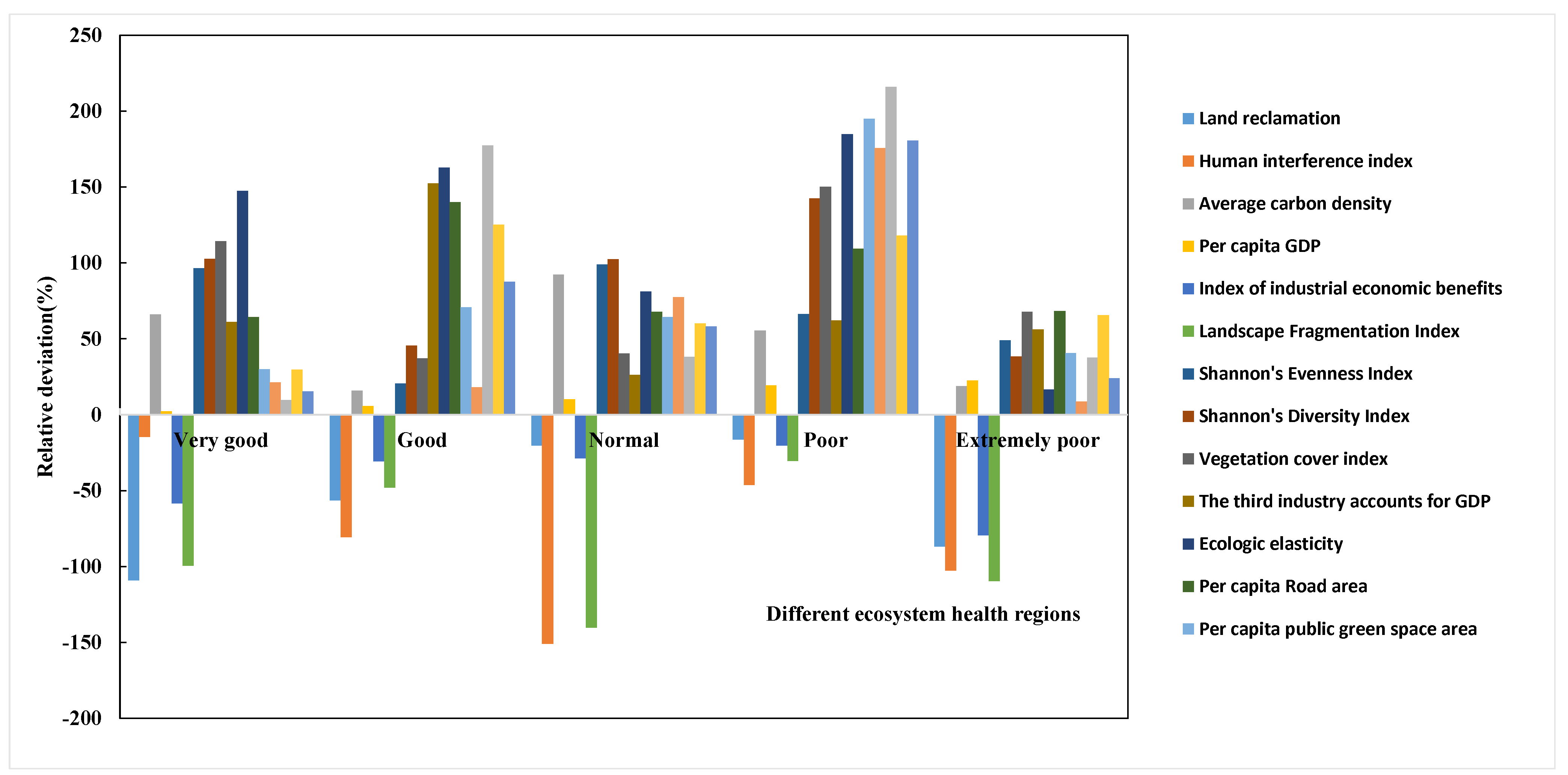

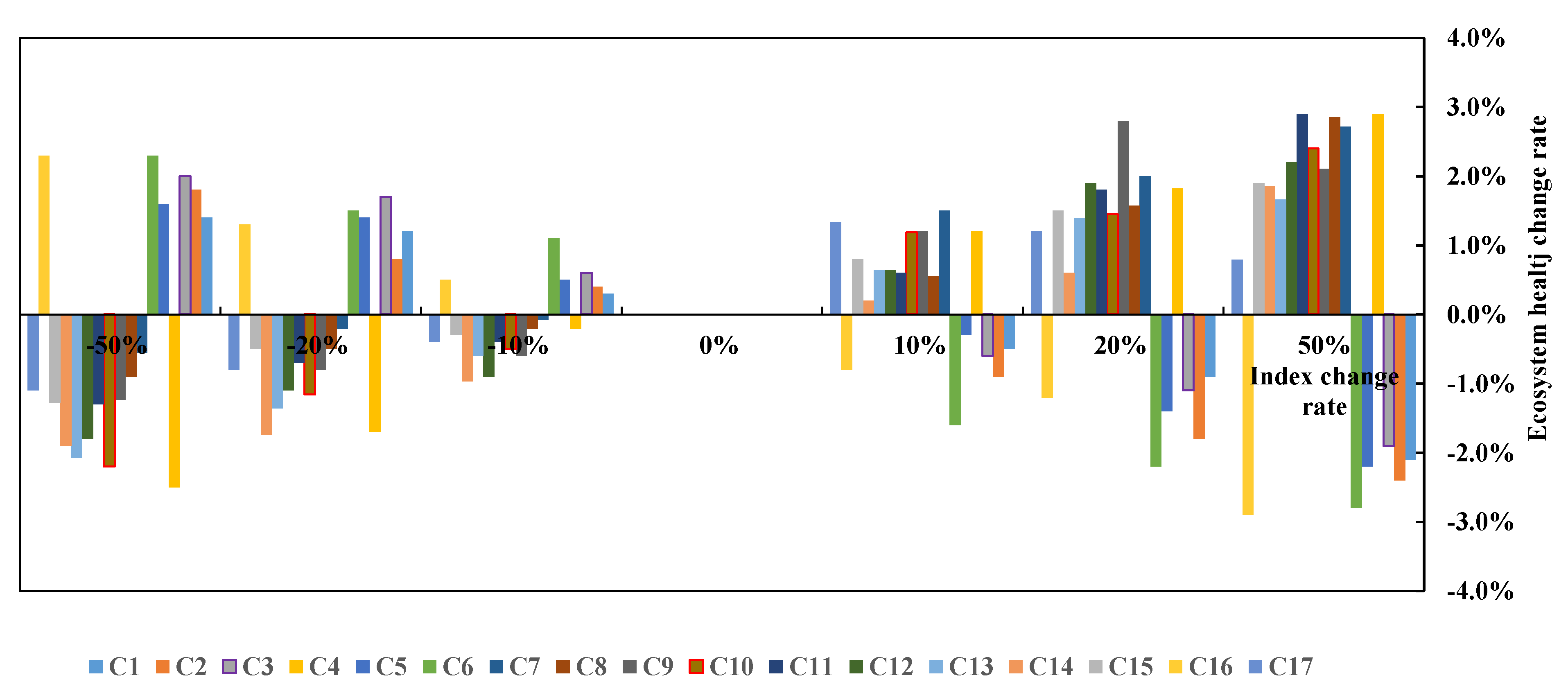
| Elements | Index Type | Index Name | Weight [36,37,38,39,40] |
|---|---|---|---|
| Pressure | Land | Land reclamation (−) C1 | 0.0678 |
| Population | Human interference index (−) C2 | 0.0661 | |
| State | Vitality | Average carbon density (−) C3 | 0.0501 |
| Per capita GDP (+) C4 | 0.0596 | ||
| Comprehensive industrial economic benefits (−) C5 | 0.0617 | ||
| Organization structure | Landscape fragmentation index (−) C6 | 0.0612 | |
| Shannon‘s evenness index (+) C7 | 0.0665 | ||
| Shannon‘s diversity index (+) C8 | 0.0625 | ||
| Vegetation cover index (+) C9 | 0.0549 | ||
| Third industry accounts for GDP (+) C10 | 0.0631 | ||
| Restoring force | Ecological elasticity (+) C11 | 0.0674 | |
| Support power | Per capita road area (+) C12 | 0.0631 | |
| Per capita public green space area (+) C13 | 0.0516 | ||
| Response | Natural response | Water and soil conservation (+) C14 | 0.0524 |
| Social and economic response | Treatment rate of industrial waste waste (+) C15 | 0.0553 | |
| Utilization of industrial solid waste (−) C16 | 0.0543 | ||
| Environmental investment accounts for GDP (+) C17 | 0.0424 |
| Health Levels | Health State | Assessment Value |
|---|---|---|
| 1 | Very good | 8.0–10.0 |
| 2 | Good | 6.0–8.0 |
| 3 | Normal | 4.0–6.0 |
| 4 | Poor | 4.0–6.0 |
| 5 | Extremely poor | 0.0–2.0 |
| Study Areas | SHEI | H | FN |
|---|---|---|---|
| Si’ming | 0.09 | 0.42 | 0.26 |
| Haicang | 0.18 | 0.68 | 0.18 |
| Huli | 0.12 | 0.53 | 0.23 |
| Ji’mei | 0.28 | 0.71 | 0.18 |
| Tong’an | 0.29 | 0.86 | 0.20 |
| Xiang’an | 0.26 | 0.72 | 0.18 |
| Licheng | 0.24 | 0.61 | 0.22 |
| Fengze | 0.19 | 0.58 | 0.24 |
| Luojiang | 0.25 | 0.62 | 0.22 |
| Quangang | 0.27 | 0.72 | 0.19 |
| Hui’an | 0.16 | 0.63 | 0.21 |
| Anxi | 0.30 | 0.83 | 0.19 |
| Yongchun | 0.31 | 0.98 | 0.17 |
| Dehua | 0.38 | 1.23 | 0.05 |
| Shishi | 0.21 | 0.69 | 0.11 |
| Jinjiang | 0.17 | 0.62 | 0.13 |
| Nan’an | 0.28 | 0.86 | 0.09 |
| Xiangcheng | 0.26 | 0.84 | 0.10 |
| Longwen | 0.18 | 0.78 | 0.16 |
| Yunxiao | 0.28 | 0.92 | 0.09 |
| Zhangpu | 0.29 | 0.96 | 0.08 |
| Zhao’an | 0.25 | 0.91 | 0.09 |
| Changtai | 0.24 | 0.81 | 0.12 |
| Dongshan | 0.27 | 0.88 | 0.07 |
| Nanjing | 0.36 | 1.08 | 0.04 |
| Pinghe | 0.31 | 1.02 | 0.08 |
| Hua’an | 0.33 | 1.06 | 0.07 |
| Longhai | 0.26 | 0.83 | 0.11 |
| Indexes Number | Ecosystem Health Levels | |||||
|---|---|---|---|---|---|---|
| Very Good | Good | Normal | Poor | Extremely Poor | Mean | |
| C1 | −109.1 | −56.4 | −20.3 | −16.3 | −86.9 | −57.8 |
| C2 | −14.7 | −80.6 | −150.9 | −46.3 | −102.8 | −79.06 |
| C3 | 66.1 | 15.8 | 92.4 | 55.4 | 18.8 | 49.7 |
| C4 | 2.4 | 5.8 | 10.1 | 19.4 | 22.5 | 12.04 |
| C5 | −58.3 | −30.8 | −28.6 | −20.3 | −79.4 | −43.48 |
| C6 | −99.3 | −48.1 | −140.2 | −30.4 | −109.5 | −85.5 |
| C7 | 96.3 | 20.5 | 99.1 | 66.3 | 48.9 | 66.22 |
| C8 | 102.8 | 45.5 | 102.5 | 142.5 | 38.4 | 86.3 |
| C9 | 114.4 | 37.0 | 40.3 | 150.2 | 67.6 | 81.9 |
| C10 | 61.0 | 152.4 | 26.3 | 62.1 | 56.1 | 71.6 |
| C11 | 147.5 | 162.8 | 81.2 | 184.7 | 16.7 | 118.6 |
| C12 | 64.3 | 139.9 | 67.6 | 109.5 | 68.4 | 89.9 |
| C13 | 29.9 | 70.8 | 64.2 | 194.9 | 40.7 | 80.1 |
| C14 | 21.3 | 18.1 | 77.4 | 175.5 | 8.7 | 60.2 |
| C15 | 9.7 | 177.2 | 38.1 | 215.9 | 37.5 | 95.7 |
| C16 | 29.6 | 125.2 | 60.2 | 117.9 | 65.6 | 79.7 |
| C17 | 15.4 | 87.5 | 58.2 | 180.8 | 23.9 | 73.1 |
© 2018 by the authors. Licensee MDPI, Basel, Switzerland. This article is an open access article distributed under the terms and conditions of the Creative Commons Attribution (CC BY) license (http://creativecommons.org/licenses/by/4.0/).
Share and Cite
Wang, Z.; Tang, L.; Qiu, Q.; Chen, H.; Wu, T.; Shao, G. Assessment of Regional Ecosystem Health—A Case Study of the Golden Triangle of Southern Fujian Province, China. Int. J. Environ. Res. Public Health 2018, 15, 802. https://doi.org/10.3390/ijerph15040802
Wang Z, Tang L, Qiu Q, Chen H, Wu T, Shao G. Assessment of Regional Ecosystem Health—A Case Study of the Golden Triangle of Southern Fujian Province, China. International Journal of Environmental Research and Public Health. 2018; 15(4):802. https://doi.org/10.3390/ijerph15040802
Chicago/Turabian StyleWang, Ziyan, Lina Tang, Quanyi Qiu, Huaxiang Chen, Tong Wu, and Guofan Shao. 2018. "Assessment of Regional Ecosystem Health—A Case Study of the Golden Triangle of Southern Fujian Province, China" International Journal of Environmental Research and Public Health 15, no. 4: 802. https://doi.org/10.3390/ijerph15040802





